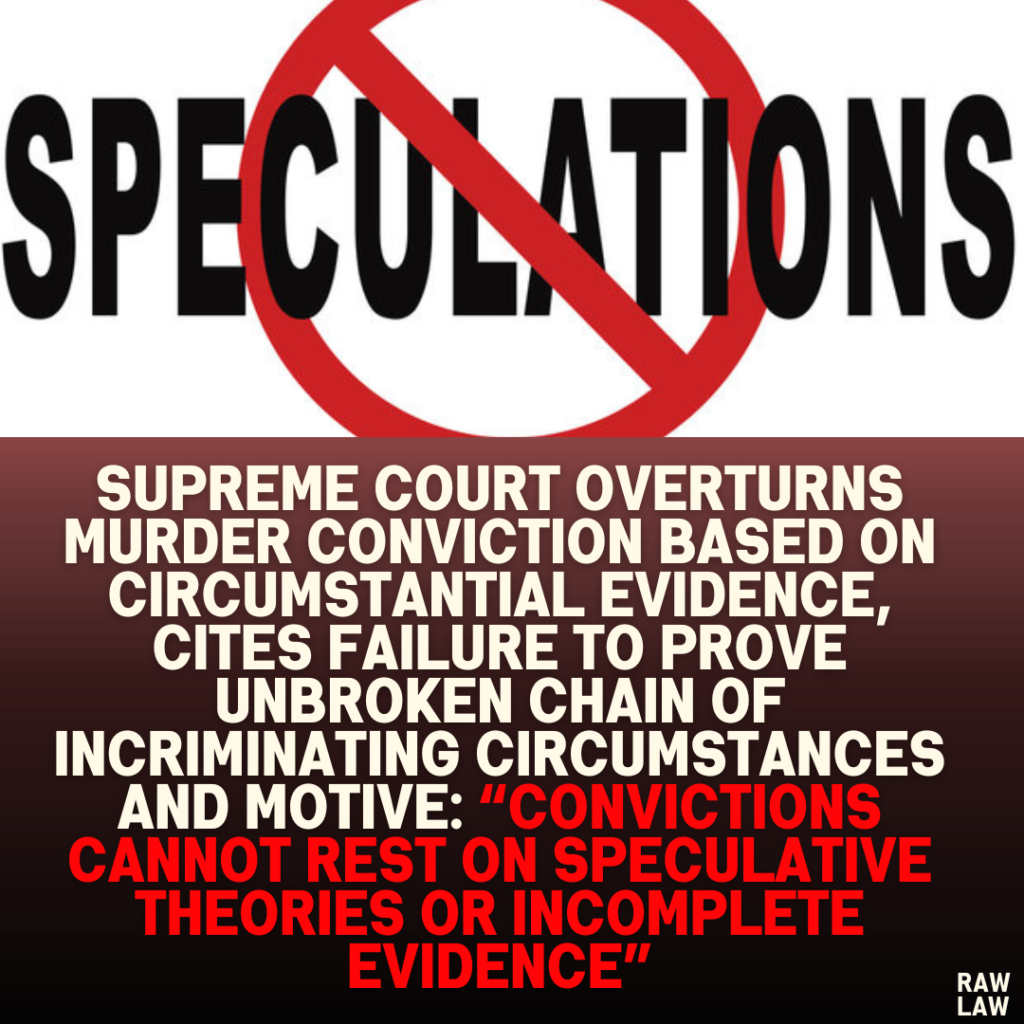Court’s Decision:
The Supreme Court of India overturned the conviction of the appellant for charges including murder, abduction, extortion, and destruction of evidence. It quashed the judgments of the Trial Court and High Court, emphasizing that the prosecution failed to establish an unbroken chain of incriminating circumstances. The appellant was acquitted and ordered to be released immediately.
Facts:
- Alleged Offense: The appellant was accused of murdering a man involved in an extra-marital affair with his wife. The prosecution claimed that the appellant, with the help of co-accused, abducted, murdered, and concealed the victim’s body.
- Conviction: The Trial Court convicted the appellant and sentenced him to life imprisonment, citing circumstantial evidence like the recovery of skeletal remains and a purported DNA match. The High Court upheld this conviction.
- Discovery and Investigation: Skeletal remains and other materials (e.g., clothing and Rs. 3,50,000 in cash) were recovered based on a supposed disclosure by the appellant to the police. DNA profiling allegedly linked the skeletal remains to the victim’s family.
Issues:
- Did the prosecution prove the alleged motive of the crime beyond doubt?
- Was the recovery of skeletal remains and other evidence legally admissible and conclusively linked to the appellant?
- Did the DNA profiling provide sufficient evidence to identify the victim?
- Was the chain of circumstantial evidence unbroken, leaving no room for reasonable doubt?
Petitioner’s Arguments:
- Fabricated Case: The appellant argued that the case was based on a fabricated theory of an extra-marital affair, which was not supported by credible evidence.
- Failure to Prove Disclosure: The prosecution failed to establish that the skeletal remains were recovered based on the appellant’s voluntary and accurate disclosure under Section 27 of the Indian Evidence Act.
- Flawed DNA Evidence: No reliable proof was presented to show that the blood samples used for DNA profiling were collected from the victim’s mother.
- Break in Circumstantial Evidence: The appellant contended that the prosecution failed to establish a complete and conclusive chain of evidence.
Respondent’s Arguments:
- Strong Circumstantial Evidence: The respondent argued that the circumstantial evidence, including the appellant’s alleged disclosure and DNA profiling, clearly pointed to the appellant’s guilt.
- Concurrent Findings: Both the Trial Court and High Court reached consistent conclusions, which should not be lightly interfered with by the Supreme Court.
- Recovery and DNA Match: The skeletal remains were discovered based on the appellant’s disclosure, and the DNA profile of the remains matched that of the victim’s mother, proving the appellant’s involvement.
Analysis of the Law:
Circumstantial Evidence:
The Court highlighted the established principles for cases based on circumstantial evidence:
- Unbroken Chain: Every link in the chain of evidence must be proven beyond doubt.
- Exclusive Guilt: The evidence must point exclusively to the guilt of the accused and be inconsistent with any hypothesis of innocence.
- Conclusive Nature: The evidence must exclude every other possibility.
- Legal Standards: The Court referred to Sharad Birdhichand Sarda v. State of Maharashtra and Babu Sahebgouda Rudragoudar v. State of Karnataka for principles governing circumstantial evidence.
Section 27 of the Evidence Act:
The Court explained the strict requirements for admissibility under Section 27 of the Indian Evidence Act:
- The disclosure statement must be voluntary and lead directly to the discovery of incriminating material.
- The Investigating Officer must narrate the exact words of the accused, and the recovery must be corroborated by independent witnesses.
Precedent Analysis:
The Court analyzed multiple judgments to reinforce its decision:
- In Sharad Birdhichand Sarda v. State of Maharashtra, the Court laid down the “five golden principles” for convicting based on circumstantial evidence.
- In Babu Sahebgouda Rudragoudar v. State of Karnataka, the Court emphasized the need for precise and corroborated proof of disclosures under Section 27.
Court’s Reasoning:
- Motive: The prosecution alleged the appellant’s motive was based on an extra-marital affair, but this was not corroborated by the victim’s family or any witness. The Court found this theory to be speculative and unsupported by evidence.
- Recovery of Evidence:
- The Investigating Officer failed to prove that the appellant disclosed the location of the skeletal remains voluntarily.
- Witnesses testified that the crime scene and remains were shown to them by the police, not the appellant, undermining the prosecution’s claims.
- DNA Profiling:
- The prosecution did not establish that the blood samples used for DNA profiling were collected from the victim’s mother.
- Testimonies from key witnesses, including the Investigating Officer and Medical Officer, contradicted the prosecution’s narrative.
- Incomplete Chain of Evidence: The Court concluded that the prosecution failed to establish a complete and unbroken chain of evidence, creating reasonable doubt about the appellant’s guilt.
Conclusion:
The Supreme Court held that the prosecution’s case was riddled with inconsistencies and failed to meet the legal standards required for conviction based on circumstantial evidence. It quashed the convictions and directed the immediate release of the appellant.
Implications:
This judgment reinforces the stringent evidentiary standards required in cases based on circumstantial evidence. It serves as a reminder that convictions cannot rest on speculative motives or incomplete chains of evidence. The ruling underscores the importance of proper procedural adherence under Section 27 of the Indian Evidence Act, ensuring fairness in criminal trials.



